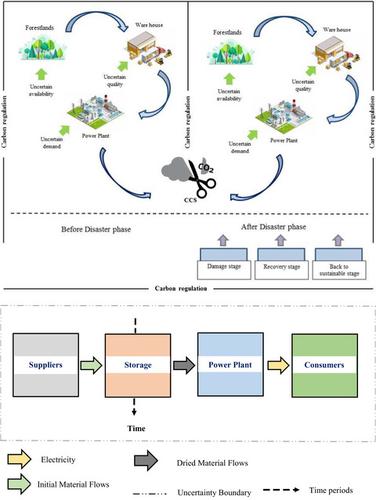当前位置:
X-MOL 学术
›
Energy Sci. Eng.
›
论文详情
Our official English website, www.x-mol.net, welcomes your
feedback! (Note: you will need to create a separate account there.)
Optimization and analysis of a bioelectricity generation supply chain under routine and disruptive uncertainty and carbon mitigation policies
Energy Science & Engineering ( IF 3.5 ) Pub Date : 2020-05-18 , DOI: 10.1002/ese3.716 Mahsa Saghaei 1 , Mohammad Dehghanimadvar 2, 3 , Hamed Soleimani 4, 5 , Mohammad Hossein Ahmadi 6
Energy Science & Engineering ( IF 3.5 ) Pub Date : 2020-05-18 , DOI: 10.1002/ese3.716 Mahsa Saghaei 1 , Mohammad Dehghanimadvar 2, 3 , Hamed Soleimani 4, 5 , Mohammad Hossein Ahmadi 6
Affiliation

|
Increasing greenhouse gas emissions and negative environmental consequences have raised worldwide attention to ecological issues. The development of carbon regulations (CRs) beside carbon capture and storage (CCS) systems is part of carbon mitigation policies (CMPs), which are following in recent years to control and manage carbon liberation. Along with environemtal policies, the utilization of renewable energy resources have been promoted significantly. However, the economic opportunities for renewable energy development considering CMPs have not addressed extensively. In this study, a stochastic mathematical programming model has been presented to minimize cost and downside risk (DSR) of the bioelectricity generation supply chain considering the pre‐ and postdisaster conditions. The role of several CMPs on the economic behavior of the system has been analyzed by investigating the potential uncertainties on material availability, material quality, and consumer demand. To consider disruption effects, the postdisaster stage has been classified into several substages including damage, recovery, and back to the sustainability stages. Mississippi State after the Katrina Hurricane is addressed as a case study to examine the performance of the proposed model. The results demonstrated that the occurrence of disruptive uncertainties creates 8,978,502 $, 8,864,335 $ and 8,884,055 $ as the DSR, under carbon tax policy (CTP), carbon offset policy (COP), and CCS, respectively. The effect of disruptive scenario  with a 15% reduction of resource has led to the greatest postdisaster supply chain costs in comparison with other scenarios. Although the financial analysis showed CTP has the greatest DSR after the occurrence of disaster, this policy has the most investment attractions, as well as COP, with the internal rate of return (IRR) of 9%. While implementing the CCS policy with the IRR of 2% creates 7% missed opportunity costs compared with other CMPs.
with a 15% reduction of resource has led to the greatest postdisaster supply chain costs in comparison with other scenarios. Although the financial analysis showed CTP has the greatest DSR after the occurrence of disaster, this policy has the most investment attractions, as well as COP, with the internal rate of return (IRR) of 9%. While implementing the CCS policy with the IRR of 2% creates 7% missed opportunity costs compared with other CMPs.
中文翻译:

在常规和破坏性不确定性以及减碳政策下优化和分析生物发电供应链
温室气体排放的增加和对环境的负面影响已引起全世界对生态问题的关注。碳捕集与封存(CCS)系统之外的碳法规(CRs)的开发是碳减排政策(CMP)的一部分,近年来,这些政策一直在控制和管理碳释放。随着环境政策的发展,可再生能源的利用得到了极大的促进。然而,考虑到CMP,可再生能源发展的经济机会尚未得到广泛解决。在这项研究中,提出了一种随机数学规划模型,以考虑到灾前和灾后的情况,从而最大程度地降低生物电发电供应链的成本和下行风险(DSR)。通过调查材料可用性,材料质量和消费者需求方面的潜在不确定性,分析了几种CMP在系统经济行为中的作用。为了考虑破坏影响,灾难后阶段已分为几个子阶段,包括破坏,恢复和回到可持续发展阶段。以卡特里娜飓风过后的密西西比州为例,研究了该模型的性能。结果表明,在碳税政策(CTP),碳补偿政策(COP)和CCS下,破坏性不确定性的产生分别创造了8,978,502 $,8,864,335 $和8,884,055 $作为DSR。破坏性情景的影响 为了考虑破坏影响,灾难后阶段已分为几个子阶段,包括破坏,恢复和回到可持续发展阶段。以卡特里娜飓风过后的密西西比州为例,研究了该模型的性能。结果表明,在碳税政策(CTP),碳补偿政策(COP)和CCS下,破坏性不确定性的产生分别创造了8,978,502 $,8,864,335 $和8,884,055 $作为DSR。破坏性情景的影响 为了考虑破坏影响,灾难后阶段已分为几个子阶段,包括破坏,恢复和回到可持续发展阶段。以卡特里娜飓风过后的密西西比州为例,研究了该模型的性能。结果表明,在碳税政策(CTP),碳补偿政策(COP)和CCS下,破坏性不确定性的产生分别创造了8,978,502 $,8,864,335 $和8,884,055 $作为DSR。破坏性情景的影响 结果表明,在碳税政策(CTP),碳补偿政策(COP)和CCS下,破坏性不确定性的产生分别创造了8,978,502 $,8,864,335 $和8,884,055 $作为DSR。破坏性情景的影响 结果表明,在碳税政策(CTP),碳补偿政策(COP)和CCS下,破坏性不确定性的产生分别创造了8,978,502 $,8,864,335 $和8,884,055 $作为DSR。破坏性情景的影响 与其他方案相比,资源减少15%导致灾难后供应链成本最大。尽管财务分析显示,灾难发生后CTP具有最大的DSR,但该政策具有最大的投资吸引力和COP,内部收益率(IRR)为9%。与其他CMP相比,在以2%的内部收益率执行CCS政策时,会产生7%的错失机会成本。
与其他方案相比,资源减少15%导致灾难后供应链成本最大。尽管财务分析显示,灾难发生后CTP具有最大的DSR,但该政策具有最大的投资吸引力和COP,内部收益率(IRR)为9%。与其他CMP相比,在以2%的内部收益率执行CCS政策时,会产生7%的错失机会成本。
更新日期:2020-05-18
 with a 15% reduction of resource has led to the greatest postdisaster supply chain costs in comparison with other scenarios. Although the financial analysis showed CTP has the greatest DSR after the occurrence of disaster, this policy has the most investment attractions, as well as COP, with the internal rate of return (IRR) of 9%. While implementing the CCS policy with the IRR of 2% creates 7% missed opportunity costs compared with other CMPs.
with a 15% reduction of resource has led to the greatest postdisaster supply chain costs in comparison with other scenarios. Although the financial analysis showed CTP has the greatest DSR after the occurrence of disaster, this policy has the most investment attractions, as well as COP, with the internal rate of return (IRR) of 9%. While implementing the CCS policy with the IRR of 2% creates 7% missed opportunity costs compared with other CMPs.
中文翻译:

在常规和破坏性不确定性以及减碳政策下优化和分析生物发电供应链
温室气体排放的增加和对环境的负面影响已引起全世界对生态问题的关注。碳捕集与封存(CCS)系统之外的碳法规(CRs)的开发是碳减排政策(CMP)的一部分,近年来,这些政策一直在控制和管理碳释放。随着环境政策的发展,可再生能源的利用得到了极大的促进。然而,考虑到CMP,可再生能源发展的经济机会尚未得到广泛解决。在这项研究中,提出了一种随机数学规划模型,以考虑到灾前和灾后的情况,从而最大程度地降低生物电发电供应链的成本和下行风险(DSR)。通过调查材料可用性,材料质量和消费者需求方面的潜在不确定性,分析了几种CMP在系统经济行为中的作用。为了考虑破坏影响,灾难后阶段已分为几个子阶段,包括破坏,恢复和回到可持续发展阶段。以卡特里娜飓风过后的密西西比州为例,研究了该模型的性能。结果表明,在碳税政策(CTP),碳补偿政策(COP)和CCS下,破坏性不确定性的产生分别创造了8,978,502 $,8,864,335 $和8,884,055 $作为DSR。破坏性情景的影响 为了考虑破坏影响,灾难后阶段已分为几个子阶段,包括破坏,恢复和回到可持续发展阶段。以卡特里娜飓风过后的密西西比州为例,研究了该模型的性能。结果表明,在碳税政策(CTP),碳补偿政策(COP)和CCS下,破坏性不确定性的产生分别创造了8,978,502 $,8,864,335 $和8,884,055 $作为DSR。破坏性情景的影响 为了考虑破坏影响,灾难后阶段已分为几个子阶段,包括破坏,恢复和回到可持续发展阶段。以卡特里娜飓风过后的密西西比州为例,研究了该模型的性能。结果表明,在碳税政策(CTP),碳补偿政策(COP)和CCS下,破坏性不确定性的产生分别创造了8,978,502 $,8,864,335 $和8,884,055 $作为DSR。破坏性情景的影响 结果表明,在碳税政策(CTP),碳补偿政策(COP)和CCS下,破坏性不确定性的产生分别创造了8,978,502 $,8,864,335 $和8,884,055 $作为DSR。破坏性情景的影响 结果表明,在碳税政策(CTP),碳补偿政策(COP)和CCS下,破坏性不确定性的产生分别创造了8,978,502 $,8,864,335 $和8,884,055 $作为DSR。破坏性情景的影响
 与其他方案相比,资源减少15%导致灾难后供应链成本最大。尽管财务分析显示,灾难发生后CTP具有最大的DSR,但该政策具有最大的投资吸引力和COP,内部收益率(IRR)为9%。与其他CMP相比,在以2%的内部收益率执行CCS政策时,会产生7%的错失机会成本。
与其他方案相比,资源减少15%导致灾难后供应链成本最大。尽管财务分析显示,灾难发生后CTP具有最大的DSR,但该政策具有最大的投资吸引力和COP,内部收益率(IRR)为9%。与其他CMP相比,在以2%的内部收益率执行CCS政策时,会产生7%的错失机会成本。










































 京公网安备 11010802027423号
京公网安备 11010802027423号